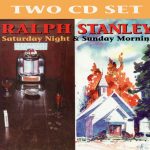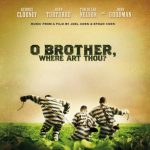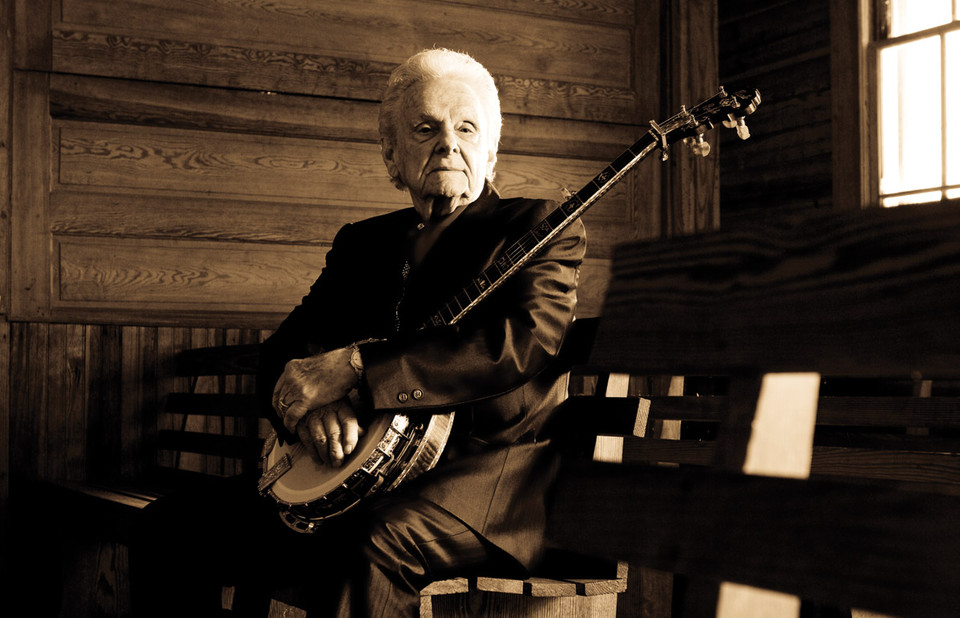By Don McLeese
Was Ralph Stanley ever young?
We have no recorded evidence that he ever sounded young, that his vocal style was once boyish. In his formative singing experience at the Primitive Baptist Church — a fundamentalist congregation in rural Virginia that forbade instrumental accompaniment — he was known as “the boy with the 100-year-old voice.” (Thanks to David Cantwell for introducing me to the quote that reinforces the point I want to make, in his superb appreciation for the New Yorker’s website.)
There is so much that distinguishes the legacy of Dr. Ralph Stanley, but that 100-year-old voice is the key: the high, keening tenor that is both unearthly and quintessentially earthly, shaped by the soil and the Clinch Mountains, the grass and the breeze. When a singer sounds young, as almost all of them do when they are young, we say that they mature as they age, developing a depth and range that comes to distinguish their work. But when a younger singer sounds so much older, as the teenaged Ralph did when the Stanley Brothers began performing and recording, the progression isn’t from callow to mature, from thin to deep, or even from old to older. It’s more like he started ageless and became timeless.
This was the unearthly quality of Stanley’s voice, the way it seemed to transcend not only the trends of the time, or the experiences and wear of those decades, but time itself. He called his post-Stanley Brothers band the Clinch Mountain Boys, but if Ralph was ever a boy, we don’t hear it.
There are three distinct stages to Ralph Stanley’s career, each improbable in light of the others, with a chronology that defies the very notion of progression, in the sense of moving forward. Each one of them alone would represent a career worth veneration. But when an artistic career has three stages, those stages typically follow the same arc and order: the formative, the peak maturity, the afterglow. Stanley was never past his peak because it wasn’t until the third stage — the improbable resurrection with “O Death!” and O Brother, Where Art Thou? — that most of mainstream America became aware of him at all. That ghostly plea and prayer of an a cappella performance became as much a signature tune for him among a new and much broader generation of listeners as “Angel Band” and “Rank Stranger” had been for a smaller group of aficionados, the ones whose appreciation dates back a half-century or more to the seminal music of the Stanley Brothers.
So, without further ado, the three stages in the music of Dr. Ralph Stanley, 1927-2016, RIP …
Carter’s kid brother
 The age difference between Carter and Ralph was about the same as that between Ira and Charlie Louvin (who were a couple years older) and Don and Phil Everly (a little more than a decade younger). Though the impetus for singing professionally with his brother reportedly came from Ralph, there was never any question about the roles the two played. They fell into them naturally, after Ralph’s discharge from the Army, in which he’d enlisted straight from high school. Carter would be the lead singer, and he was the natural front man, far more outgoing and assertive than his reserved younger brother. Ralph would play the banjo to his brother’s guitar and provide those preternaturally high harmonies, giving the Stanley Brothers that blood blend that distinguishes family acts.
The age difference between Carter and Ralph was about the same as that between Ira and Charlie Louvin (who were a couple years older) and Don and Phil Everly (a little more than a decade younger). Though the impetus for singing professionally with his brother reportedly came from Ralph, there was never any question about the roles the two played. They fell into them naturally, after Ralph’s discharge from the Army, in which he’d enlisted straight from high school. Carter would be the lead singer, and he was the natural front man, far more outgoing and assertive than his reserved younger brother. Ralph would play the banjo to his brother’s guitar and provide those preternaturally high harmonies, giving the Stanley Brothers that blood blend that distinguishes family acts.
In retrospect, their sound was seminal, though Bill Monroe would accuse them of being copycats and bluegrass bandwagon jumpers (much as he resented Flatt & Scruggs) before their reconciliation. Their output was prolific, some 300 sides in two decades, extending from the early mountain music that predated bluegrass through hymns and spirituals through Carter’s secular originals. And their legacy continues to inspire, as the Stanley Brothers have become synonymous for close harmonies and a stylistic purity — “old-time mountain style,” a term that Ralph preferred to “bluegrass” — uncontaminated by the trends of the times.
Again, all of this is in retrospect, for throughout the Stanley Brothers’ career, their regional style was marginal music at best within the wider strain of marginal music known as Country & Western. They only had one national country hit, a 1960 novelty number titled “How Far to Little Rock.” (The follow-up, “Still Trying to Get to Little Rock,” didn’t fare as well.) They had even given up on music entirely for a brief spell, moving for gainful employment in the Detroit Ford plant in the early ‘50s.
With the folk boom of the early 1960s, the Stanley Brothers found a new audience and a new context for their music at festivals and on college campuses, performing with other acoustic regionalists for audiences that prized some notion of purity and authenticity. Among this crowd, commercial success might be more of a stigma than a draw. Elsewhere, the rise of rock had hit both country and its bluegrass offshoot hard.
Thus, the death of Carter Stanley in 1966 drew little attention. He was 41, and, unlike his younger brother, he drank heavily, resulting in cirrhosis of the liver. He had left the stage a few weeks earlier, at a school auditorium in Kentucky, and that was the end of the Stanley Brothers.
Brother takes charge
It seems like it might have been tough for Ralph Stanley to decide whether to continue. He was 39 years old. He had just lost not only his brother, but the duo’s lead singer and principal songwriter and showman. The reticent younger brother had never felt comfortable at center stage. And it wasn’t as if the Stanley Brothers were a commercial juggernaut with a momentum to sustain.
Yet he barely skipped a beat, reportedly taking less than a week to recommit to performing and soon to recording as Ralph Stanley and the Clinch Mountain Boys. That decision was not only crucial for Ralph’s career, obviously, but for the Stanley Brothers’ legacy, which fell to the hands of the younger brother. Though Ralph had demonstrated that he could execute the up-tempo lickety-split on banjo that bluegrass audiences had come to expect, his own interests lay more with traditional songs and soaring harmonies than with displays of instrumental virtuosity.
Bluegrass would continue to surge forward, to progress, to morph into “new grass” and “Dawg music” and all sorts of fusions that would attract younger audiences. But Ralph and band went back, back to the Clinch Mountains, back to tradition, a move he felt Carter might have resisted. He stripped down his banjo style to his essence and continued reviving the traditional and spiritual songs on which he’d cut his teeth.
And, of course, he continued to sing the Stanley Brothers staples, now taking the lead rather than providing the harmony, and introducing those songs to fans who hadn’t been alive, or aware, when the Stanley Brothers had been recording. Thus the Stanley Brothers became even more influential after the fact, as Ralph’s performances led fans to discover (or rediscover) the duo’s formative, foundational work.
Though his inclinations might have been at odds with the propulsive, supercharged dynamics that characterized so much of bluegrass innovation, his instincts fit well with what was happening in rock, with the Byrds, the Band and the Burritos, along with Bob Dylan, all moving toward turning down the amplification and tuning out the trends of the times, embracing a more rural and rustic aesthetic after the psychedelic excesses of the 1960s.
Stanley as a solo artist achieved a stature as the embodiment of dignity and unvarnished purity, elevating and extending the legacy of the Stanley Brothers in the process. His Clinch Mountain Boys served as a training ground for formative country stars — most notably Ricky Skaggs and Keith Whitley — and other country luminaries became willing or even eager to grace his recordings with duets, as if some of that purity would rub off on them. Singing with them let Ralph provide those high harmonies that remained his signature.
Stanley’s solo career would last more than twice as long as that of the Stanley Brothers, though academics and aficionados still point to those Stanley Brothers classics as the pinnacle achievement of that music. Ralph Stanley released plenty of albums on a number of labels over the decades after Carter’s death, but the ones that drew the most attention put a fresh spin on classics that dated to the Stanley Brothers or even older traditional material.
 Perhaps the pinnacle release of that phase of Stanley’s career was 1992’s double album, Saturday Night and Sunday Morning, which contrasted and complemented the weekend’s dance with the next morning’s worship and found Stanley harmonizing with such acolytes as Dwight Yoakam, Vince Gill, Emmylou Harris and Patty Loveless. It’s a masterpiece, but it is beyond the reach of streaming services and often tough to find. And the more artists who sang with Stanley, the more others wanted to sing with him. Bob Dylan (who had recorded “Rank Strangers” on Down in the Groove) purportedly told Stanley that singing with him was the highlight of his career.
Perhaps the pinnacle release of that phase of Stanley’s career was 1992’s double album, Saturday Night and Sunday Morning, which contrasted and complemented the weekend’s dance with the next morning’s worship and found Stanley harmonizing with such acolytes as Dwight Yoakam, Vince Gill, Emmylou Harris and Patty Loveless. It’s a masterpiece, but it is beyond the reach of streaming services and often tough to find. And the more artists who sang with Stanley, the more others wanted to sing with him. Bob Dylan (who had recorded “Rank Strangers” on Down in the Groove) purportedly told Stanley that singing with him was the highlight of his career.
So, Ralph Stanley’s place in the pantheon was secure, and so was that of the Stanley Brothers. He would have enjoyed a most remarkable career even if we ended the account right here. But the most remarkable phase was yet to come.
O Brother!
 It’s safe to say that most of those who have marveled at the voice of Ralph Stanley first heard it when he sang the a cappella “Oh Death” on the Grammy-winning, multiplatinum soundtrack for O Brother, Where Art Thou? He sounded himself like Death, or death warmed over, and it gave the listener chills. Stanley was 74, and this was his popular breakthrough. Much of the album and its surprise success seemed like a validation of the values that Stanley had long embodied, with the traditional material and the spare or non-existent musical accompaniment striking a responsive chord that transcended genre or generation.
It’s safe to say that most of those who have marveled at the voice of Ralph Stanley first heard it when he sang the a cappella “Oh Death” on the Grammy-winning, multiplatinum soundtrack for O Brother, Where Art Thou? He sounded himself like Death, or death warmed over, and it gave the listener chills. Stanley was 74, and this was his popular breakthrough. Much of the album and its surprise success seemed like a validation of the values that Stanley had long embodied, with the traditional material and the spare or non-existent musical accompaniment striking a responsive chord that transcended genre or generation.
The Stanley Brothers themselves has recorded “O Death” almost half a century earlier, an up-tempo arrangement with bluegrass instrumentation and far less gravitas. They had also recorded “Man of Constant Sorrow” in a rendition very similar to that which also appeared on the O Brother soundtrack, sung by the much younger Dan Tyminski (George Clooney would mouth it in the movie, and Ralph could hardly sound like Clooney would look.)
Producer T Bone Burnett would subsequently be given his own label imprint and would sign Stanley (along with Rodney Crowell) for his boutique roster. The “Down from the Mountain” tour in the wake of the soundtrack’s success would find Stanley playing bigger and fancier halls for higher ticket prices than ever before. He was awarded the prestigious National Medal of Arts in 2006. He received an honorary doctorate (his second) from Yale in 2014. He was a national treasure, no longer confined to the margins of bluegrass or folk or mountain music.
When he died June 23 at the age of 89, his place in American music was secure, and well-deserved. But what an unlikely route he had taken to reach it. The few veteran artists who enjoy such career longevity typically hit their peak during the first half and then coast or rest on their laurels after that. Ralph Stanley hit a peak in his mid 70s that brought a much larger audience and a fresh perspective to everything that he had accomplished before. It took almost a hundred years, but that hundred-year-old voice belatedly received every bit of the renown it had long deserved.






No Comment